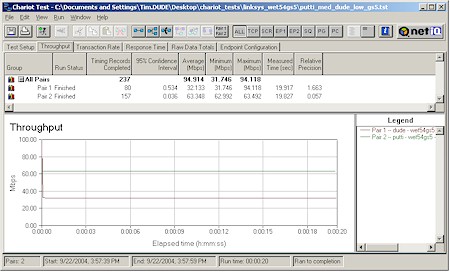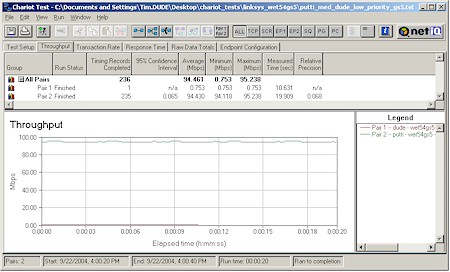QoS Performance Testing - Priority Features, Contiunued
I next moved everything back to the GS5 and tried changing port priorities to see if the GS5 behaved as Linksys' documentation described. Figure 12 shows a test run with the Celeron machine's port set to Low priority, the Pentium 4's port set to Medium and the Athlon 64 endpoint machine set to High. With these settings and the Weighted Fair Queue method in use, I expected a 2:1 ratio between the two machines, which is just about what I got (63.3 vs. 32.1 Mbps).

Figure 12: QoS Priority Test - Medium and Low, Weighted Fair Queue Mode
(click on the image for a larger view)
I also tried this test with High and Low and Critical and Low priorities and have pulled all the results into the table below.
| Setting | Average Throughput 1 | Average Throughput 2 | Measured ratio | Expected Ratio | Variance |
| Medium & Low | 63.3 | 32.1 | 1.97 | 2.0 | -1.4% |
| High & Low | 76.1 | 19.4 | 3.92 | 4.0 | -1.9% |
| Critical & Low | 84.2 | 11.0 | 7.65 | 8.0 | -4.5% |
| Table 1: QoS Weighted Fair Queue Priority Variance | |||||
I doubt you'd ever notice these variances, but you would definitely notice the effect of changing the Global QoS mode from Weighted Fair Que to Priority. Figure 13 shows what happened when I did just that.

Figure 13: QoS Priority Test - Medium and Low, Priority Mode
(click on the image for a larger view)
The setup for this test was the same as for Figure 12, with the only change being the Global QoS mode. Since packets in the higher priority queue are always forwarded first, whichever test pair got started second basically had to wait until the first pair was finished or briefly stopped sending data. As you can see from the plots, IxChariot doesn't pause often! Using this mode on a busy LAN could definitely send any user set to a Low priority back to a dial-up like experience!